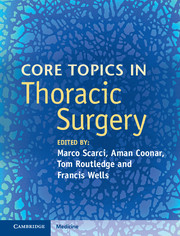Book contents
- Frontmatter
- Contents
- List of contributors
- Section I Diagnostic work-up of the thoracic surgery patient
- Section II Upper airway
- Section III Benign conditions of the lung
- Section IV Malignant conditions of the lung
- Section V Diseases of the pleura
- Section VI Diseases of the chest wall and diaphragm
- Section VII Disorders of the esophagus
- 23 Benign esophageal disease
- 24 Esophageal cancer
- 25 Esophageal perforation
- Section VIII Other topics
- Index
- References
25 - Esophageal perforation
from Section VII - Disorders of the esophagus
Published online by Cambridge University Press: 05 September 2016
- Frontmatter
- Contents
- List of contributors
- Section I Diagnostic work-up of the thoracic surgery patient
- Section II Upper airway
- Section III Benign conditions of the lung
- Section IV Malignant conditions of the lung
- Section V Diseases of the pleura
- Section VI Diseases of the chest wall and diaphragm
- Section VII Disorders of the esophagus
- 23 Benign esophageal disease
- 24 Esophageal cancer
- 25 Esophageal perforation
- Section VIII Other topics
- Index
- References
Summary
Introduction
Oesophageal perforation is a potentially life-threatening condition that presents a diagnostic and therapeutic challenge. It is a surgical emergency associated with high mortality and morbidity, especially if the diagnosis is delayed. Presentation is often ambiguous or atypical, making diagnosis challenging, and management remains controversial. Evidence for treatment is mainly based on case series and fraught with bias.
The first case of spontaneous perforation of the oesophagus was described by Boerhaave in 1723. The first successful repair of a spontaneous perforation of the oesophagus were reported by Barrett and Olsen in 1947. Although spontaneous perforation of the oesophagus is a relatively uncommon condition, the dramatic increase in the use of endoscopy for the diagnosis and treatment of gastrointestinal diseases has led to a significant increase in incidence of oesophageal perforation.
Etiology and pathophysiology
In order to understand the aetiology and pathophysiology better, one should have a good anatomical knowledge of the oesophagus. The oesophagus is a muscular tube approximately 25 cm in length, starting from the lower border of the cricoid cartilage and ending at the gastro-oesophageal junction, where it joins the stomach. There are three anatomical points of narrowing: the cricopharyngeus muscle, broncho-aortic constriction and the gastro-oesophageal junction. Perforation can occur anywhere as the oesophagus lacks a serosal layer which provides stability through elastin and collagen fibres, but these anatomical narrowings are more prone to rupture.
Perforation of the oesophagus leads to leakage of oesophageal and gastric contents, saliva, bile, digestive enzymes and other substances into the mediastinum, causing soiling and leading to mediastinitis. The mediastinal collection often ruptures into the pleural cavity leading to pleural effusion, empyema or hydropneumothorax.
The degree of inflammation depends upon the time interval between the actual perforation and the clinical presentation and the amount of contamination. The presence of bacteria in saliva and the digestive enzymes in the stomach lead to a mixed necrotizing infection. Left untreated, it rapidly progresses to sepsis and multi-organ failure.
Etiology
Oesophageal perforations can broadly be divided into intraluminal and extraluminal causes (Table 25.1).
Intraluminal causes
Iatrogenic/instrumental injuries
With the increased use of endoscopy and endoluminal therapies, this has become the leading cause of oesophageal perforation. Up to 70% of oesophageal injuries are caused by instrumentation.
- Type
- Chapter
- Information
- Core Topics in Thoracic Surgery , pp. 240 - 252Publisher: Cambridge University PressPrint publication year: 2016

